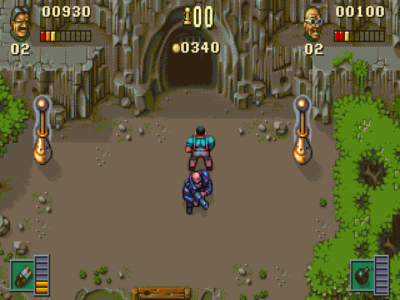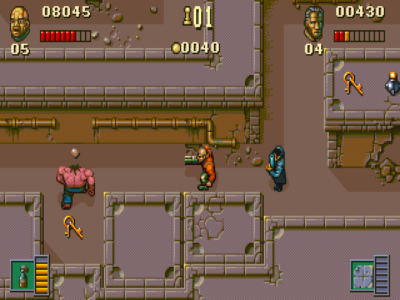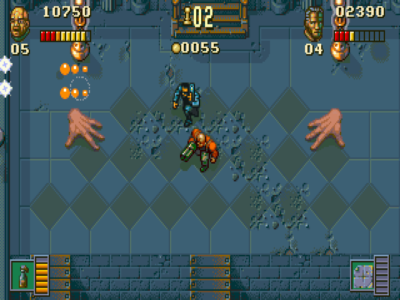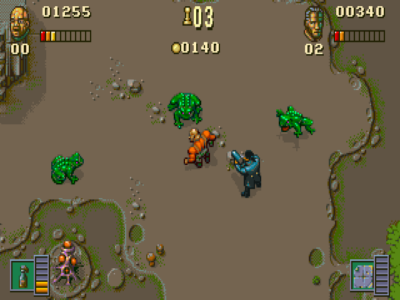
The Chaos Engine
Written by: Rik
Date posted: March 5, 2007
- Genre: Action
- Developed by: Bitmap Brothers
- Published by: Renegade
- Year released: 1994
- Our score: 6
While modern technology has enabled some of the high production values normally employed in Hollywood to be displayed on our PC monitors, there can be little doubting that for all the wonderful explosions and celebrity voice-overs in action games these days, the storytelling (bar one or two exceptions) leaves a lot to be desired. Though the likes of Half-Life and Deus Ex may be enough to impress us gaming chimps, show it to Joe Public and he’ll most likely respond with a dismissive shrug.
Still, while a good story is always welcome, it isn’t really what you play these kinds of games for. Hark back to the good ol’ days, when games came on floppy disks and there wasn’t much room for any superfluous mucking around, and you’d be lucky to get an intro screen or a hastily written paragraph in the manual telling you what the point of it all was. Most of the time, we wouldn’t even be paying attention or just skip past it, because it was the gameplay we were interested in, not the window-dressing. Ah, to go back to simpler times…[Sigh]

Aside from blasting baddies, you have to activate ‘nodes’ scattered throughout each level to progress. Don’t ask me why though.
Actually, that’s not what I meant to say at all. I’ll start again. Back then, story wasn’t important, especially for shooter-type games, so, not surprisingly, developers didn’t put a whole lot of effort in. Take the story for The Chaos Engine, for example. Here’s some of the text from the intro screen, quoted verbatim:
“Sometime in the last century, an experimenter with time, space and early computers created a bizarre machine – THE CHAOS ENGINE. Although powerful, the machine became incredibly powerful and turned against its creator. Its power to corrupt time and matter was out of control – a cloud of chaos descended over the land, humans and animals were turned into ravenous beasts. The results were soon discovered…” [cue picture of a large, deceased, robotic dinosaur]
What bollocks! In fact, it’s on the border line between English and total gibberish – if you typed that into an e-mail and sent it to one of your mates, the spam filter would probably file it alongside those asking for his/her bank account details and advertising viagra.

Visit the clockworks and face hundreds of bare-chested grunts. It’s worse than being at a Newcastle United match.
As we’ve said already, though, this wasn’t a big factor for gamers back then, and those who rushed to the shops to buy The Chaos Engine were probably doing so on the basis of generally positive reviews, not to mention the fact that it was developed by the kings of 16-bit gaming, The Bitmap Brothers. The game is a top-down shooter which sees you take control of one of a selection of mercenaries (each with different abilities) and then, aided either by a computer or another human player, proceed to blast your way through sixteen levels on the way to finally taking on and destroying the machine of the game’s title.
The first thing to say about this game is that it’s pretty difficult. Perhaps it’s all these years of being pandered to by games that let you quicksave around each corner, but I found The Chaos Engine a pretty ruthless experience. You start the game with three lives – every two levels, you have the opportunity to visit a shop and buy extra energy or lives (if you’ve collected enough money – left by every enemy you’ve killed – that is) but you don’t actually get to a permanent save point until you’ve completed the first four levels, whereupon you’re rewarded with a password. These levels are no walk in the park, either, and though you can get away with a limited amount of reckless blundering on the very first one, from level two onwards, it’s relentlessly unforgiving stuff.
The challenge lies mainly in blasting wave after wave of baddies, which come in various forms, including huge disembodied hands and suicidal robotic frogs, within quite a cramped playing area. Generally they all follow a similar pattern of heading straight for you while emitting deadly blobs that gently float your way, but though they aren’t that smart, getting the upper hand is still a challenge, especially when you really can’t take that many hits before losing a life. You rarely can see where the baddies are going to come from next, as every time you walk around a corner or pick anything up, a new wave of them seem to be generated. In fairness to the story, this is where the whole ‘Chaos Engine’ thing kind of makes sense – it’s a massive great baddie-generating machine that needs to be stopped at all costs (I guess there are only so many ways to explain why an almost infinite number of grey gargoyle men keep emerging from the shrubbery to try and kill you).
Anyway, progress is possible after a bit of practice (providing you haven’t severed your arm halfway up by smashing your fist through the monitor in frustration first) and the odds are evened up a little by the inclusion of an RPG-style system which allows you to boost your mercenaries’ stats. And there’s really no point in bitching about the difficulty level when this is just the game’s way of making sure the whole thing isn’t over with too quickly.

Is there anything creepier than a big hand running at you and stuff? Well, yes, actually – they look pretty silly.
Graphically, The Chaos Engine has aged pretty well, and though a little bit of VGA-chunkiness is evident, the whole thing looks pretty smart. The sound, however, is a bit of a disappointment, with effects reduced to the occasional explosion (criminally, none of the game’s meaty-looking weapons make any sound at all) and the cracking music evident in other 16-bit versions replaced by some comparatively puny MIDI renditions which generally fail to impress.
In fact, perhaps the biggest criticism that can be levelled at the game is that this PC version isn’t the best available, and Bitmap Brothers die-hards will probably prefer to dust off their old Amigas or boot up an emulator in order to experience the game in all its original splendour. While you probably didn’t buy your PC to play games like this, The Chaos Engine remains one of the better games of its type available, and certainly one of the best from the Bitmap Brothers back-catalogue. If arcade shooters are your bag, you should definitely give this one a go.



 Posts
Posts
Comparing the versions, apart from the obvious music issue, this game did not really benefit from the additional colours. Ironically, it looks much better in 5 bit colour depth instead of 8: The dusty, industrial tone-in-tone look just feels appropriate to the setting.
February 11, 2014 @ 8:31 pm